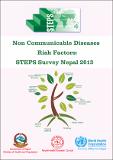Please use this identifier to cite or link to this item:
https://hdl.handle.net/20.500.14356/2673Full metadata record
| DC Field | Value | Language |
|---|---|---|
| dc.contributor.author | Aryal, Krishna Kumar | - |
| dc.contributor.author | Neupane, Sushhama | - |
| dc.contributor.author | Mehata, Suresh | - |
| dc.contributor.author | Vaidya, Abhinav | - |
| dc.contributor.author | Singh, Sunil | - |
| dc.contributor.author | Paulin, Frank | - |
| dc.contributor.author | Madanlal, Renu Garg | - |
| dc.contributor.author | Riley, Leanne Margaret | - |
| dc.contributor.author | Cowan, Melanie | - |
| dc.contributor.author | Guthold, Regina | - |
| dc.contributor.author | Singh, Shanker Pratap | - |
| dc.contributor.author | Bhusal, Chop Lal | - |
| dc.contributor.author | Lohani, Guna Raj | - |
| dc.date.accessioned | 2025-02-17T05:39:19Z | - |
| dc.date.available | 2025-02-17T05:39:19Z | - |
| dc.date.issued | 2014 | - |
| dc.identifier.citation | Aryal, KK; Neupane, S; Mehata, S; Vaidya, A; Singh, S; Paulin, F; Madanlal, RG; Riley, LM; Cowan, M; Guthold, R; Singh, SP; Bhusal, CL; Lohani, GR; (2014) Non communicable diseases risk factors: STEPS Survey Nepal 2013. Kathmandu: Nepal Health Research Council | en_US |
| dc.identifier.uri | https://hdl.handle.net/20.500.14356/2673 | - |
| dc.description | Research Report. | en_US |
| dc.description.abstract | Executive Summary: The emerging pandemic of non communicable diseases (NCDs) is creating major health challenges globally. The burden of non communicable diseases is also increasingly affecting developing countries such as Nepal. Similar to other low and middle income countries, Nepal is facing a triple burden of diseases: communicable diseases, re-emerging diseases and an escalation of non communicable diseases. Cardiovascular diseases, cancer, chronic obstructive pulmonary diseases and diabetes have been identified by the World Health Organization (WHO) as the four major NCDs worldwide. These diseases are driven by various forces including ageing, rapid unplanned urbanisation and the globalisation of unhealthy lifestyles. The World Health Report 2002 states the eight major risk factors (four behavioural and four biological) that contribute most to the development of NCDs (WHO 2002). To reduce NCDs it is important to focus on decreasing the risk factors associated with these diseases and mapping the epidemic of NCDs and their risk factors. In Nepal, the first national-level NCD risk factor survey was conducted in 2007/08 to determine the prevalence of modifiable behavioural risk factors; however, this survey did not cover biological risk factors. Against this backdrop, the current study was conducted in 2012/13 (five years later) to collect baseline data on biological risk factors and determine the distribution of modifiable behavioural risk factors (NCD risk factors) among the Nepalese population. | en_US |
| dc.description.sponsorship | Government of Nepal, Ministry of Health and Population World Health Organization, Country office for Nepal | en_US |
| dc.language.iso | en_US | en_US |
| dc.publisher | Nepal Health Research Council (NHRC), Ram Shah Path, Kathmandu, Nepal | en_US |
| dc.subject | Non Communicable diseases | en_US |
| dc.subject | STEPS survey Nepal 2013 | en_US |
| dc.title | Non Communicable diseases risk factors: STEPS survey Nepal 2013 | en_US |
| dc.title.alternative | STEPS survey Nepal 2013 | en_US |
| dc.type | Research report | en_US |
| Appears in Collections: | NHRC Research Report | |
Files in This Item:
| File | Description | Size | Format | |
|---|---|---|---|---|
| noncommunicable-disease-report_2012_2013.pdf | Full Report Download. | 4.11 MB | Adobe PDF |  View/Open |
Items in DSpace are protected by copyright, with all rights reserved, unless otherwise indicated.
